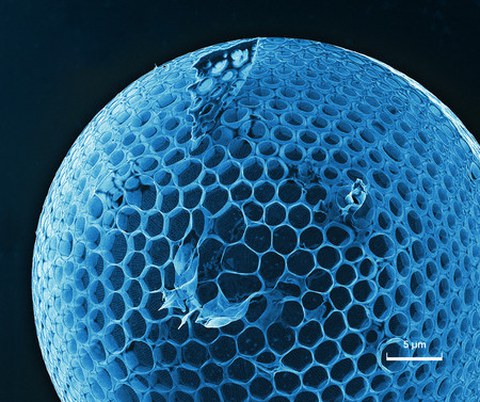Examination of Biomineralization in Diatoms by Means of Biological Solid-State NMR and Optical Imaging
The term "biomineralisation" denotes the formation of inorganic material under the control of an organism. The main function of these biominerals is the stabilisation and protection of the soft organic tissue. Examples are the calcium phosphates of bones and teeth of vertebrate animals as well as the shells of mussels or algae consisting of calcium carbonate or silica. These biominerals exhibit remarkable material properties. Today, the industrial production of these materials is hardly possible. Therefore, it is important to analyse and understand the basic processes and principles of biomineralisation in nature.

Scanning helium ion micrograph of a Diatom (Stephanopyxis turris)
Diatoms are unicellular, photosynthetic eukaryotes, which can be found in sea as well as in freshwater. They play a crucial role in the fixation of CO2 and circulation of SiO2 in the oceans. However, their most striking feature is their species-specific silicified cell wall which exhibits beautiful, regularly structured patterns which are precisely reproduced during each cell division. Diatom cell walls consist of inorganic amorphous hydrated silica. In addition, certain organic components can be found which are closely attached to the inorganic material. These organic components are supposed to play a key role in the formation of highly structured cell walls.
Within several projects, our group investigate the process of biosynthesis of amorphous silica in diatoms in cooperation with the Prof. Dr. Karl-Heinz van Pée (Biochemistry) and Prof. Dr. Nils Kröger ( Biomimetic Materials ), Research unit FOR 2038 Nanopatterned Organic Matrices in Biological Silica Mineralization"). Especially by using modern solid-state NMR spectroscopic techniques, we investigate the silica-organic interface in diatom biosilica as well as the contribution of biomolecules in the process of silica deposition.
Together with the group of Dr. Christoph Krafft (IPHT Jena) we use optical imaging by Raman spectroscopy and non-linear microscopy for in vivo- and in vitro-analysis of single diatom cells/ cell walls.
